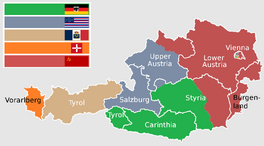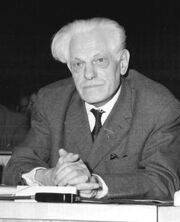| |||||||||||||||||||||||||||
East Austria (German: Ostösterreich), officially the East Austrian Democratic Republic (German: Ostösterreichische Demokratische Republik), was a country in Central Europe, that existed from 1949, until reunification in 2022.
The history of the modern state began after World War II, when the Danubian state of Austria was divided into five occupation zones. Plans were made for eventual reunification, but neither the United States nor the Soviet Union could agree on whether a reunified Austria should be a Western capitalist nation or an Eastern communist state. Negotiations broke down, and in May 1949, the German, American, French and Swiss occupation zones unified to create the Republic of Austria (West Austria). In retaliation, the Soviets established a nation out of their eastern occupation zone called the Austrian Democratic Republic.
For several years, both East and West Austria claimed to be the legal government of all Austria, with the Western bloc supporting West Austria's claim and the Eastern bloc supporting East Austria's claim. After noticing a large number of East Viennese people entering West Vienna, a wall was built between the two cities, causing a rise in tensions between the two sides of the Cold War. However, relations were improved in the late 1970s, especially with the transition from communism to social-democracy, and on 19 July 1978, diplomatic relations were formally established between East and West Austria, officially relinquishing their claims of each other.
History[]
Establishment of communist state (1945-1949)[]

Map of the occupation
Negotiations for reunification of the occupation zones had gone underway between 1945 and 1949, as originally planned. However, the Communist Party of Austria lead by Johann Koplenig had gained power in the eastern zone, and their position was formally established by the Soviets. The western powers were strictly against a socialist politician ruling over Austria, and wanted Austria to be a Western-aligned country. In 1948, Soviet premier Leon Trotsky initiated a blockade on western Vienna to prevent supplies from going in, although called it off a year later after planes airlifted food to the people of West Vienna. This was the final nail to the coffin that was reunification.
After realising the fact that no one could come to a proper agreement, in May 1949, the French, American and Swiss zones were organised into one federal state known as the Republic of Austria, and was part of the Western bloc. Leon Trotsky was displeased with this, as he was still willing to fight for an Austrian communist state. Despite this, as revenge he allowed Koplenig establish an eastern Austrian communist state under Soviet influence - thus, the Austrian Democratic Republic was established.
In the 1949 constitution, the East Austrian government didn't recognise the Austrian government in the west, and laid claim to the entire Austria, including all of Vienna. This claim was supported by almost all communist states, including the Soviet Union, while being disputed by the western powers; in the West Austrian constitution (until 1978), West Austria all claimed all of Austria.
Early Cold War (1949-1970)[]

Johann Koplenig, 1963
East Austria as a country was formed in the beginning of tensions between the Western bloc lead by the United States and China, and the Eastern bloc lead by the Soviet Union. East Austria found itself in the middle of the tensions, making its role significant in the Cold War, especially since the divided Vienna was the centre of multiple crisis's. Koplenig's rule from 1949 to his death in 1968 was one of an authoritarian dictatorship, as he gradually gained a cult of personality. In July 1957, after protests began in Eisenstadt, he authorised the police to shoot any protestors, which was condemned by the western world, although the Soviet government tried to defend Koplenig's decision, claiming "the protests were fascists trying to restore the glory of the Starhembergite regime".
In 1961, Koplenig and his government (along with the Soviet government) announced the construction of the Vienna Wall in order to prevent any of its citizens from moving into West Vienna. The decision was criticised by the western world, including the United States under Prime Minister John F. Kennedy, who said that "democracy is not perfect, but we have never had to put a wall up to keep our people in, to prevent them from leaving us."
Transition to social-democracy (1970-1980)[]
Economic liberalisation (1980-2007)[]
Split with the Soviet Union (2007-2018)[]
Talks of reunification (2018-present)[]
Politics[]
Government[]
Administrative divisions[]
| ||||||||||||||||||||


